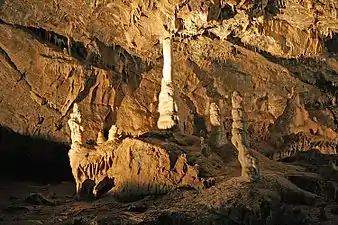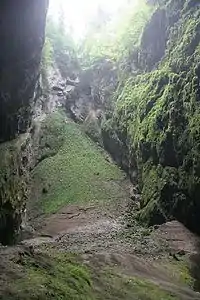Moravian Karst
The Moravian Karst (Czech: Moravský kras) is a karst landscape and protected nature reserve to the north of Brno in the eastern part of the Czech Republic, located near the town of Blansko. It encompasses a number of notable geological features, including roughly 1100 caverns and gorges and covers an area of roughly 92 km².[1] Currently, five of the cave systems (Punkva Caves (discovered by Karel Absolon), Balcarka Cave, Kateřinská Cave, Výpustek Cave and Sloupsko-šošůvské Caves+Kůlna Cave) are open for public tours; another - Amatérská Cave, Býčí skála Cave or Stránská skála (out of the border) only for science exploration.
| Moravian Karst | |
|---|---|
 Punkevní jeskyně, one of the most popular caves in the region | |
 | |
| Location | Blansko, Czech Republic |
| Area | 92 km2 (36 sq mi) |
| Website | www |

This region is also home to one of the most important single geological features in the Czech Republic, the Macocha Abyss, a gorge 138 m deep, which was formed when the ceiling of a cave chamber collapsed. Macocha Abyss is also the place where the Punkva River begins to run underground through the Punkva cave system, and two small pools of water are visible at the surface.
The Moravian Karst is a popular tourist attraction in the local area, and large numbers of tourists visit in the summer months. In addition to caverns, the nature preserve contains well-marked bicycle trails and hiking paths to explore.
See also
References
- http://www.moravskykras.net/en/moravian-karst.html Accessed 9-4-2008.
External links
- Moravian Karst Show Caves Administration (English)
- Blansko town site with tourism information
- Information on the caves from showcaves.com
| Wikimedia Commons has media related to Moravian Karst. |
